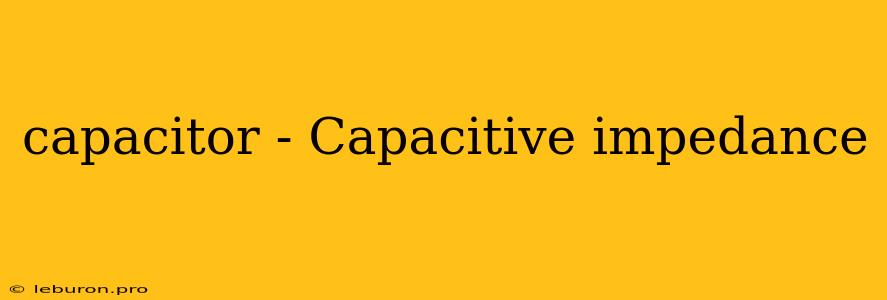Capacitors are fundamental components in electronic circuits, playing a crucial role in energy storage, filtering, and various other applications. Understanding the capacitive impedance, also known as reactance, is essential for effectively utilizing capacitors in circuit design. This impedance, unlike resistance, varies with the frequency of the applied signal and is directly related to the capacitor's ability to store and release electrical energy. This article delves into the concept of capacitive impedance, exploring its relationship with frequency, capacitance, and the overall behavior of circuits containing capacitors.
Capacitive Impedance: A Frequency-Dependent Resistance
Unlike resistors, which offer a constant opposition to current flow regardless of frequency, capacitors exhibit a dynamic impedance that changes with the frequency of the applied signal. This impedance, termed capacitive impedance or reactance, is inversely proportional to the frequency and the capacitance value.
The Formula for Capacitive Impedance
The capacitive impedance (Xc) can be calculated using the following formula:
Xc = 1 / (2πfC)
Where:
- Xc is the capacitive impedance in ohms (Ω).
- f is the frequency of the signal in Hertz (Hz).
- C is the capacitance of the capacitor in Farads (F).
This formula highlights the inverse relationship between capacitive impedance and both frequency and capacitance. As frequency increases, capacitive impedance decreases, and vice versa. Similarly, as capacitance increases, capacitive impedance decreases.
Understanding Capacitive Impedance
To grasp the concept of capacitive impedance, let's consider the charging and discharging behavior of a capacitor. When a voltage is applied across a capacitor, it starts to store electrical charge. The rate at which this charge accumulates depends on the capacitance value and the frequency of the applied voltage.
High Frequency vs. Low Frequency
- High Frequency: At high frequencies, the voltage across the capacitor changes rapidly. This rapid change encourages the capacitor to charge and discharge quickly, resulting in a lower opposition to current flow. Therefore, capacitive impedance is low at high frequencies.
- Low Frequency: Conversely, at low frequencies, the voltage across the capacitor changes slowly. This slow change allows the capacitor to accumulate a significant amount of charge before it starts to discharge. As a result, the opposition to current flow is higher, leading to a higher capacitive impedance.
Applications of Capacitive Impedance
The frequency-dependent nature of capacitive impedance makes capacitors valuable components in various applications, including:
1. Filtering:
Capacitors are extensively used in filtering circuits to block specific frequencies while allowing others to pass through. By choosing the appropriate capacitance value, one can design filters that effectively remove unwanted frequencies from signals. For instance, in audio circuits, capacitors are used to remove low-frequency hum or other unwanted noise.
2. Coupling:
In signal coupling, capacitors act as frequency-dependent bridges between different stages of a circuit. They allow high-frequency signals to pass through while blocking low-frequency signals, effectively isolating the stages from each other. This is crucial in amplifying circuits where it's essential to avoid unwanted feedback or signal interference.
3. Timing Circuits:
Capacitors can be used in conjunction with resistors to create timing circuits, such as RC oscillators. The time constant of an RC circuit, which determines the charging and discharging time of the capacitor, is directly related to the capacitance value and the resistance value. By adjusting these parameters, one can achieve desired timing characteristics.
4. Energy Storage:
Capacitors are fundamental components in energy storage systems. Their ability to store electrical charge makes them suitable for applications like power backup systems, smoothing out voltage fluctuations, and providing short bursts of high power.
Impedance and Resonance
In circuits containing both capacitors and inductors, capacitive impedance plays a crucial role in the concept of resonance. Resonance occurs when the capacitive impedance (Xc) and inductive impedance (Xl) are equal in magnitude, leading to a condition where the circuit readily accepts energy at the resonant frequency. This phenomenon has numerous applications in radio circuits, filters, and oscillators.
Conclusion
Capacitive impedance is a fundamental property of capacitors that significantly affects their behavior in circuits. Its frequency-dependent nature makes capacitors invaluable for filtering, coupling, timing, and energy storage applications. Understanding the relationship between capacitive impedance, frequency, capacitance, and resonance is essential for effectively designing and analyzing electronic circuits. By mastering these concepts, engineers and technicians can leverage the unique properties of capacitors to achieve desired circuit characteristics and functionalities.
